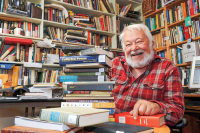Capturing success in a jar
 It’s about preserving tradition — delicious tradition.
It’s about preserving tradition — delicious tradition.
“We live in a small town, and it’s wonderful when you start meeting local farmers and seeing what they’re trying to do, trying to support themselves by living off the land,” said Jessica DeMarco. “It’s appealing, and we want to help support this concept, this way of life.”
Fresh from the farm: Meat gets a sizzling reception at farmers market
 By Paul Clark • Correspondent
By Paul Clark • Correspondent
Mary McNeil carried her shopping bag around Haywood’s Historic Farmers Market like a kid on Halloween. In went fresh-ground sausage, newly prepared chorizo and a few cuts of meat from animals that spent the summer happily munching Haywood County’s glorious green grass.
Walking through the market outside the Haywood Arts Regional Theatre on a crisp fall day, McNeil felt good not only about the quality of meat she was buying from a surprisingly large number of meat vendors, but also about what she was doing for the local economy. Buying meat from local farmers helps them keep their land in farms and their families in the pink.
Cultivating dreams in Appalachia
 Sunshine spills into Jackson County. The warm late summer rays cascade down into the mountains, ultimately flowing into the fields of Balsam Gardens. A handful of figures are seen wandering the mystical property, picking some of the freshest and finest produce found in Western North Carolina.
Sunshine spills into Jackson County. The warm late summer rays cascade down into the mountains, ultimately flowing into the fields of Balsam Gardens. A handful of figures are seen wandering the mystical property, picking some of the freshest and finest produce found in Western North Carolina.
“Being able to remake my own little piece of society in the way that I want to with my hands is what keeps me going,” said Steven Beltram.
Growing pains: Farmers pay the price as elk herd damage crops, fences
 It is a common story — a species once eliminated returns to find not everyone welcomes it back with open arms. The return of wolves to northern Wisconsin, the reintroduction of beavers to the United Kingdom, and now the elk in Western North Carolina.
It is a common story — a species once eliminated returns to find not everyone welcomes it back with open arms. The return of wolves to northern Wisconsin, the reintroduction of beavers to the United Kingdom, and now the elk in Western North Carolina.
After disappearing from North Carolina in the late 1700s, the elk have since made a comeback from the history books in the Great Smoky Mountains National Park — from zero to a successful and ever-growing herd in short time. But with their renewed success in their historic home, so comes a newfound set of problems.
Fumes kill one, hospitalize a dozen in Macon
 An incident at a farm facility in Macon County last week left one worker dead and caused the hospitalization of more than a dozen people.
An incident at a farm facility in Macon County last week left one worker dead and caused the hospitalization of more than a dozen people.
Volunteers glean picked-over fields to feed the hungry
 At the end of every crop’s season, farmers pick the fruits or vegetables that are pretty enough to sell in the grocery store. Once they are done, they plow under the leftover produce.
At the end of every crop’s season, farmers pick the fruits or vegetables that are pretty enough to sell in the grocery store. Once they are done, they plow under the leftover produce.
From farm to table
 Get to know your local farmers and learn some tricks from green thumb masters during the annual Jackson County Farm Tour and Garden Walk from 1 to 5 p.m. this weekend, July 20 and 21.
Get to know your local farmers and learn some tricks from green thumb masters during the annual Jackson County Farm Tour and Garden Walk from 1 to 5 p.m. this weekend, July 20 and 21.
The tour takes participants from sheep farms to urban gardens on a self-guided agricultural jaunt across Jackson County. The event gives the public a chance to meet the farmers who grow and raise their food. It is put on by the Jackson County Farmer’s Market.
The fading glory of Burley: Once a staple cash crop, only a handful of tobacco fields are still hanging on
 This year, Bill Holbrook will start drawing on the “old man pension” — as this local tobacco farmer likes to refer to Social Security. At 66 years old, Holbrook is one of the older, if not the oldest, tobacco growers left in Haywood County.
This year, Bill Holbrook will start drawing on the “old man pension” — as this local tobacco farmer likes to refer to Social Security. At 66 years old, Holbrook is one of the older, if not the oldest, tobacco growers left in Haywood County.
Buffalo rancher plans herd expansion into cattle country
Frank King is on a mission to find the perfect meat. King, the owner of King Bio Natural Medicine, holistic pharmaceutical company based in Asheville, is testing and researching different types of animals that will prosper in the Western North Carolina climate while at the same time provide nourishing steaks and burgers.
Wrangling bison: A delicate dance with 2,000 pounds and four hooves
 As the small, all-terrain vehicle drew near, the buffalo snorted and then lowered its massive head. It shuffled its feet, kicking up red dust into the Western North Carolina wind.
As the small, all-terrain vehicle drew near, the buffalo snorted and then lowered its massive head. It shuffled its feet, kicking up red dust into the Western North Carolina wind.
“Don’t worry,” said Mike Ellington, manager of a buffalo ranch in Buncombe County and former rodeo clown. “He’s doesn’t want to fight. But he’s getting ready in case we want to.”





